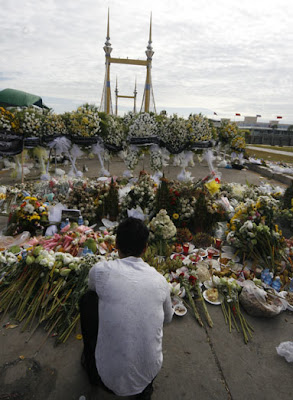A mourner at Diamond Island’s north bridge this week, in front of floral tributes. Photo by: HENG CHIVOAN
--------------------------------------------------------------People returning to the countryside after injuries may find life very difficult – no one will understand their situation.
--------------------------------------------------------------
via CAAI
Wednesday, 01 December 2010 15:00 Dr Nick Walsh
IT was with disbelief that I heard rumours of a crush at Diamond Island. I switched on the television at about 12:30am. Initially, it was thought scores of people were killed and injured, but the toll soon rose. By the morning, it was well over 300.
It’s still hard to believe that so many people perished, literally a stone’s throw away, in the heart of Phnom Penh. The atmosphere around town was subdued the morning after, except outside the major hospitals where crowds of anxious relatives and onlookers fought to locate missing family members. The sight of bodies laid out, side by side, was deeply disturbing. When life leaves the human body, it has a deafening permanence. But there were hundreds of others, on drips in corridors, recovering from the physical and emotional trauma. Most seemed OK physically. However, the emotional scars will linger for much longer.
Hurricane Katrina, the Haitian earthquake, the tsunami, a school shooting, a bushfire, Mumbai siege, and 9/11 – these devastating events hit TV screens across the world. We watch, transfixed, as incomprehensible events evolve in some distant part of the globe. Soon, the news stories move on in their hypomanic frenzy. We never know what remains. Or how individuals and communities learn to adapt, to cope – what the consequences are for the next generation.
We are ill-prepared for catastrophes. These are the events that happen to others, elsewhere. In many ways, life is more pleasurable being ill-prepared. Who would like to live with the constant paranoia of being caught in a tsunami, a hurricane or a panicked crowd?
We experience fear and anxiety for a reason – it protects us. We’re scared of snakes for a reason – although when fear becomes disproportionate to the threat, as in phobias, the consequences can be incapacitating. So, too, with post-traumatic stress disorder.
The risk of developing this is high for those involved with disasters or life-changing events. It may not develop straight away, but can simmer for several months. Flashbacks, nightmares and edginess, poor sleep and often a disengagement with previously enjoyable activities make life very difficult for the individual and their family. It’s a condition of remembering what should be forgotten.
In Cambodia, people returning to the countryside after injuries or exposure to the stampede may find life very difficult at home – no one will truly understand their situation.
Those living in Phnom Penh face the issue of whether to ever return to Koh Pich or avoid it completely. Avoidance of thoughts and reminders of traumatic events is one of the features of PTSD. Returning to the site can trigger panic attacks and traumatising emotional responses, such as thinking it is happening again.
Reprogramming emotionally charged memories is extremely difficult. The younger one is that experiences trauma, the harder it is for them. Essentially there needs to be a normalisation of the emotional reaction: “That was how I coped with that very difficult time – it’s over and isn’t going to happen again.” This takes time, therapy and lots of support. Some manage to cope.
For some, the symptoms are devastating and life is never the same. Combat-related fatigue and combat-stress reaction – once known as shell shock – are manifestations of chronic PTSD. Many people self-manage the anxiety associated with PTSD with alcohol or other drugs, which is a risky strategy.
Prevention is also difficult. Military pre-battle courses do not seem to protect against PTSD. Interestingly, the administration of sedatives like alcohol or benzodiazepines can reduce the chances of developing symptoms, presumably because it interferes with the laying down of memories associated with the event.
Treatment during or just after the event with medication may help. Medications that reduce the ‘stress response’ can reduce the development of symptoms, but evidence is not strong.
For example, cortisol consolidates emotional memories and temporarily prevents memory recall. Administering cortisol during or soon after traumatic events may inhibit recall, thus reducing the likelihood of developing long-term PTSD. Other examples which may inhibit the stress response are anti-anxiety drugs and those that block adrenalin.
Long-term treatment involves antidepressants and cognitive behavioural therapy to reduce the impact of PTSD on one’s life. Clearly, those affected in Phnom Penh will not have access to these avenues. In a country with the trauma of the Pol Pot era, will this event have a more significant or more reduced impact on peoples’ lives?
The New York community, for example, is forever changed from 9/11. Nevertheless, every community will experience disaster in different ways, depending on the connection of individuals with a community directly connected with the event. Emergency personnel often carry the greatest brunt, beyond the victims themselves. These are community members who work together, so the experience is shared.
One wonders how those involved in dismantling the tangle of bodies and injured at Koh Pich will manage in the coming days and weeks. In a city the size of Phnom Penh, the stampede could conceivably become a geographically isolated event, relatively inconsequential to those on the outside.
However, the Water Festival will forever have to live with the ghosts of the deceased. Next year may be a very different event – smaller crowds, for a start – and perhaps a curtailed celebratory atmosphere for some years to come.
Phnom Penh is now changed. The stampede’s death toll of 351 is only surpassed by a handful of similar events worldwide. This toll won’t reflect the persistent effect which that tragic night’s events will have on the local community and families linked to that night. Millions of years of evolution still have not prepared us for the trauma of experiencing, in person, just how fragile life can be.


No comments:
Post a Comment